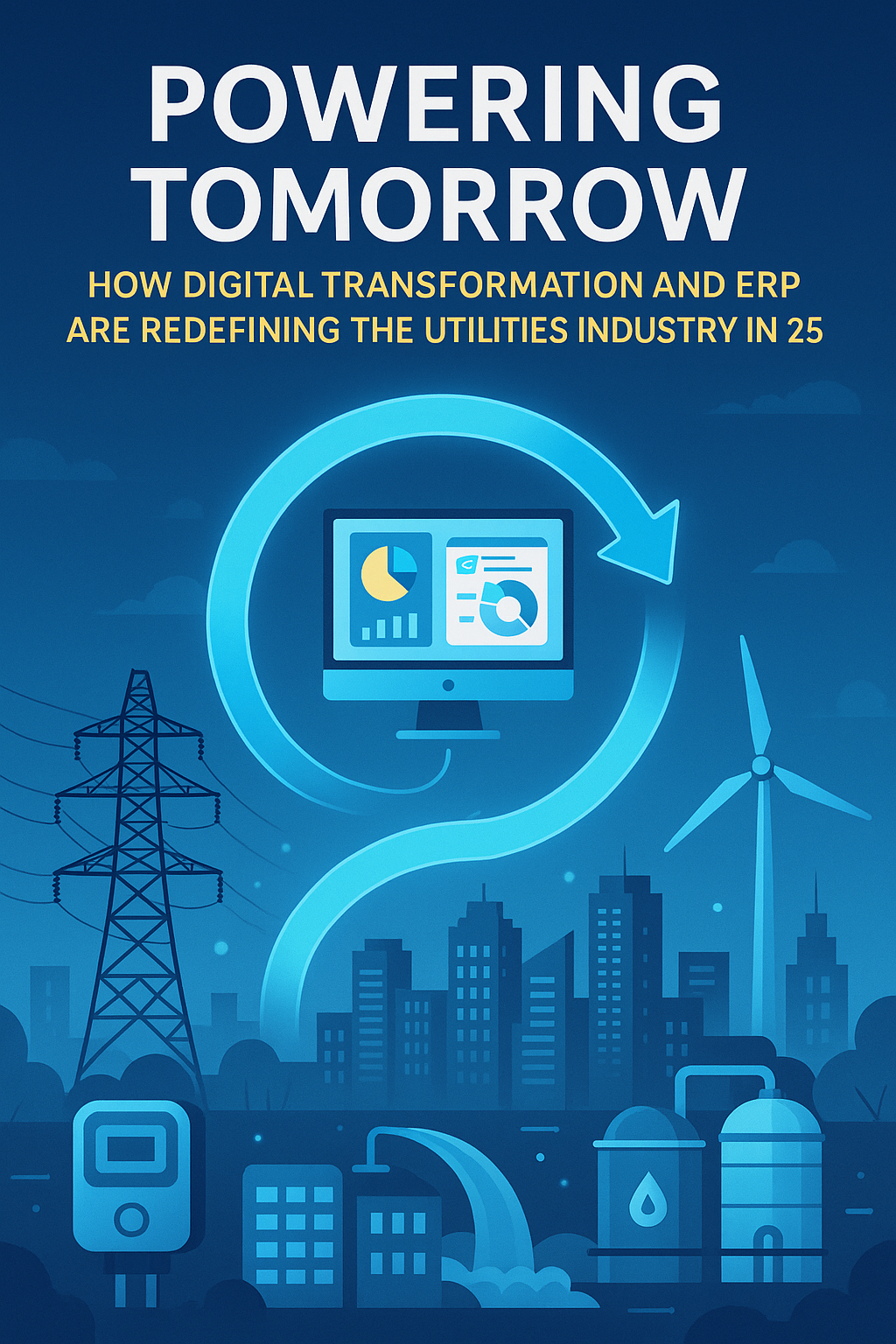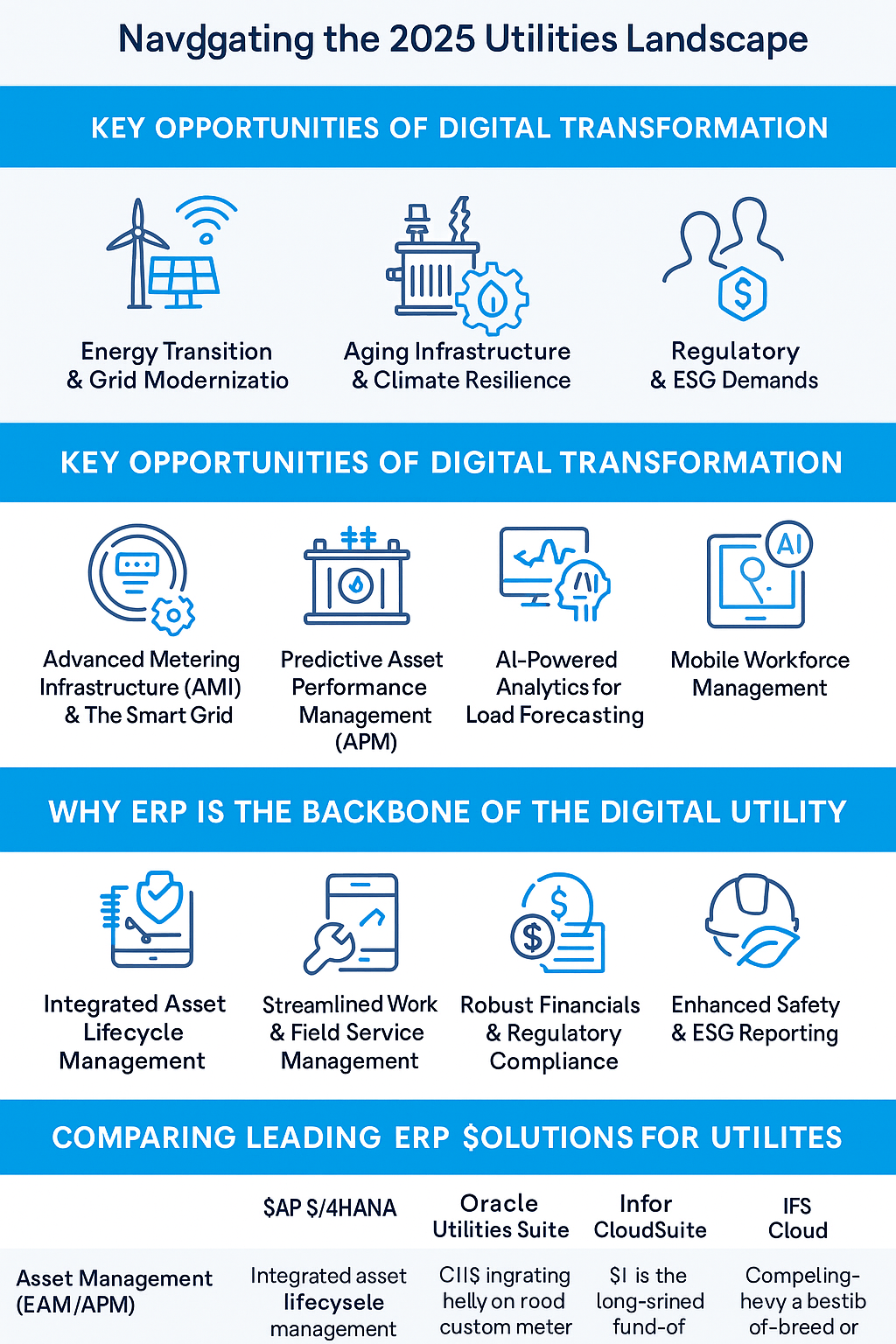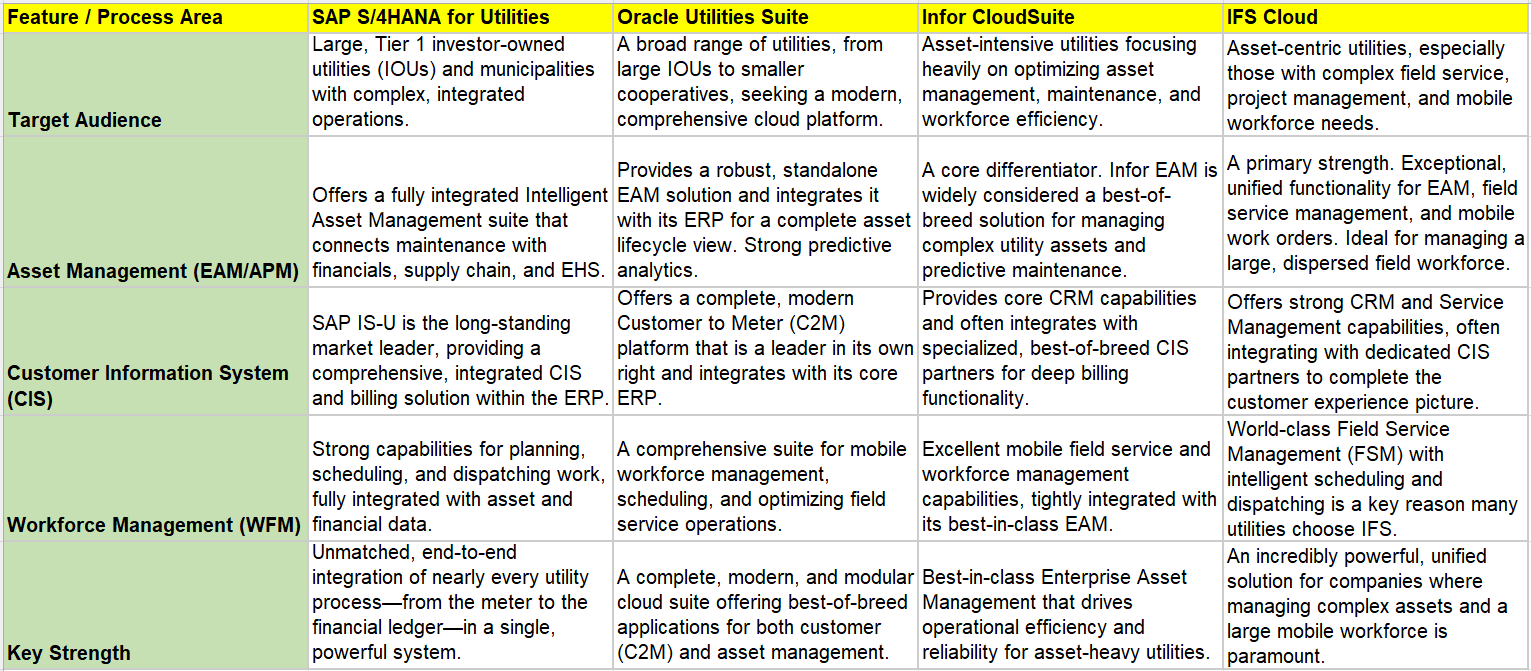Powering Tomorrow: How Digital Transformation and ERP are Redefining the Utilities Industry in 2025
2025-07-30 · By Anil Kancharla · 6 min read
❤️ 0 Likes · 👁️ 0 Views
 AI-generated image for illustration purposes only.
AI-generated image for illustration purposes only.
Powering Tomorrow: How Digital Transformation and ERP are Redefining the Utilities Industry in 2025
 AI-generated image for illustration purposes only.
AI-generated image for illustration purposes only.
The utilities industry, the silent, steadfast backbone of modern life, is in the midst of its most profound transformation in a century. From the electricity that cools our homes during scorching Texas summers to the clean water in our taps, these essential services are facing a confluence of unprecedented pressures. Aging infrastructure, the urgent push for decarbonization, escalating cybersecurity threats, and the lessons learned from severe weather events have created a new operational reality.
In this challenging new era, the traditional utility model of one-way power flow and reactive maintenance is no longer sustainable. The future belongs to the digital utility—an agile, predictive, and customer-centric enterprise. This evolution is being powered by a wave of digital transformation, and at its absolute core, serving as the unifying intelligence, is modern Enterprise Resource Planning (ERP) software.
This in-depth blog post will explore the complex landscape of the 2025 utilities industry, uncover the immense opportunities of its digital revolution, and provide a comparative analysis of leading ERP solutions that are empowering utilities to not just survive, but thrive.
The New Current: Navigating the 2025 Utilities Landscape
Today's utility—whether in electricity, natural gas, or water—is contending with forces that are fundamentally reshaping its business model and operational imperatives.
- The Energy Transition and Grid Modernization: The shift to renewable energy sources like wind and solar is creating a two-way, decentralized grid. Managing this distributed energy resource (DER) landscape, where consumers are also producers ("prosumers"), requires a level of grid intelligence and flexibility that legacy systems cannot handle.
- Aging Infrastructure and Asset Performance: Much of the nation's grid and pipeline infrastructure was built decades ago and is nearing the end of its operational life. The challenge is not just replacing these assets, but doing so intelligently—using data to prioritize investments and predict failures before they cause catastrophic outages.
- Climate Resilience and Extreme Weather: Here in the Gulf Coast and across the world, extreme weather events are becoming more frequent and intense. Utilities must build resilient systems capable of withstanding these shocks and restoring service rapidly after a disruption.
- Evolving Customer Expectations: Modern customers expect the same seamless, digital experience from their utility that they get from Amazon or Netflix. This means self-service portals, real-time outage information, personalized energy-saving tips, and proactive communication.
- Intensifying Regulatory and ESG Demands: Regulators and investors are placing immense pressure on utilities to improve safety, demonstrate sustainability, and report transparently on Environmental, Social, and Governance (ESG) metrics.
The Digital Revolution: Key Transformation Opportunities
Digital transformation provides a powerful toolkit to address these challenges head-on, turning operational burdens into opportunities for innovation and efficiency.
- Advanced Metering Infrastructure (AMI) & The Smart Grid: Smart meters are the foundation. They provide two-way communication, allowing utilities to gather granular consumption data in real-time. This data fuels everything from precise load forecasting and outage detection to time-of-use pricing and demand response programs that help balance the grid during peak times.
- Predictive Asset Performance Management (APM): This is a paradigm shift from reactive, "fix-it-when-it-breaks" maintenance. By deploying IoT sensors on transformers, pumps, and pipelines, utilities can collect data on temperature, pressure, and vibration. AI and machine learning algorithms then analyze this data to predict potential failures weeks or months in advance, allowing for planned, cost-effective maintenance that prevents outages.
- Digital Twins and Geospatial Information Systems (GIS): A digital twin is a living, virtual replica of a physical asset, like a substation or a water distribution network. Integrated with GIS data, it allows operators to visualize the entire network, simulate the impact of a storm, plan new infrastructure, and train staff in a risk-free environment.
- AI-Powered Analytics for Load Forecasting: AI can analyze vast datasets—including historical consumption, weather forecasts, and economic indicators—to predict energy demand with incredible accuracy. This allows for more efficient power generation and purchasing, reducing costs and ensuring grid stability.
- Mobile Workforce Management: Equipping field crews with tablets and mobile applications that are integrated with the central ERP system is a game-changer. Technicians can receive work orders digitally, access asset history and schematics on-site, order parts, and close out jobs in real-time, dramatically improving the efficiency and safety of field operations.
The Unifying Core: Why ERP is the Backbone of the Digital Utility
With a flood of data from smart meters, IoT sensors, and mobile crews, how does a utility connect these disparate streams of information and turn them into coherent, actionable intelligence? This is the mission-critical role of a modern Enterprise Resource Planning (ERP) system.
An ERP designed for the utilities sector breaks down the historical silos between Information Technology (IT) and Operational Technology (OT). It serves as the single source of truth that integrates asset data, customer information, financials, and workforce management into one unified platform.
Core Benefits of a Utilities ERP:
- Integrated Asset Lifecycle Management: An ERP provides a 360-degree view of every asset, from procurement and installation to maintenance and retirement. Work orders generated from a predictive maintenance alert are automatically linked to inventory, scheduling, and financial records.
- Streamlined Work and Field Service Management: When a customer reports an outage, the information flows from the Customer Information System (CIS) to the ERP, which then automatically generates a work order, checks crew availability, and dispatches the nearest qualified technician via their mobile device.
- A Modernized Customer Experience: By integrating the CIS with the ERP, customer service representatives have a complete view of a customer's account, billing history, and any active service orders, enabling faster and more effective problem resolution.
- Robust Financials and Regulatory Compliance: Utilities operate in a complex financial environment. An ERP automates complex plant accounting, manages capital projects, and simplifies the process of gathering and reporting the vast amounts of data required by regulatory bodies like the Public Utility Commission (PUC).
- Enhanced Safety and ESG Reporting: ERP systems include modules for Environment, Health, and Safety (EHS) that track safety incidents, manage employee certifications, and monitor environmental compliance. This data is essential for transparent ESG reporting to investors and stakeholders.
Comparing the Power Players: Leading ERP Solutions for the Utilities Industry
Choosing an ERP is one of the most significant technology decisions a utility will make. The leading vendors offer powerful, pre-configured solutions designed for the industry's unique needs.

The Future is Connected
The utility of tomorrow will not be judged simply on reliability, but on its intelligence, its resilience, and its relationship with its customers and community. Digital transformation is the pathway to this future, and a modern, industry-specific ERP is the engine that will power the journey. By breaking down silos, harnessing data, and integrating operations from the grid edge to the balance sheet, utilities can successfully navigate the complexities of 2025 and build a safer, cleaner, and more reliable energy and water future for all.
💌 Enjoyed this article?
If you found this post valuable, subscribe to my newsletter for more insights on digital transformation, AI, and business innovation.
👉 Subscribe to the newsletterOr let’s connect on LinkedIn — I share weekly content that’s practical for CIOs, CFOs, and transformation leaders.
🔗 Connect with me on LinkedIn